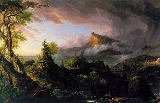
The Course of Empire
Encyclopedia
The Course of Empire is a five-part series of paintings created by Thomas Cole
in the years 1833-36. It is notable in part for reflecting popular American sentiments of the times, when many saw pastoralism
as the ideal phase of human civilization, fearing that empire would lead to gluttony and inevitable decay.
The series was acquired by The New-York Historical Society
in 1858 as a gift of the New-York Gallery of Fine Arts, and comprises the following works: The Course of Empire - The Savage State; The Course of Empire - The Arcadian or Pastoral State; The Course of Empire - The Consummation of Empire; The Course of Empire - Destruction; and The Course of Empire - Desolation.
The series of paintings depicts the growth and fall of an imaginary city, situated on the lower end of a river valley, near its meeting with a bay of the sea. The valley is distinctly identifiable in each of the paintings, in part because of an unusual landmark: a large boulder is precariously situated atop a crag overlooking the valley.
A direct source of literary inspiration for The Course of Empire paintings is Byron's Childe Harold's Pilgrimage
(1812–18). Cole quoted this verse, from Canto IV, in his newspaper advertisements for the series:
The paintings are currently on display at The New-York Historical Society
. They were temporarily exhibited in Tate Britain
in 2002.
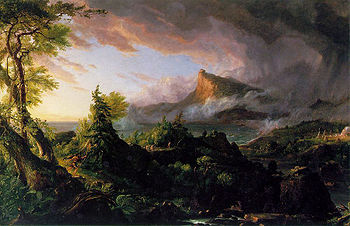 The first painting, The Savage State, shows the valley from the shore opposite the crag, in the dim light of a dawning stormy day. A hunter clad in skins hastens through the wilderness, pursuing a deer; canoes paddle up the river; on the far shore can be seen a clearing with a cluster of wigwams around a fire, the nucleus of the city that is to be. The visual references are those of Native American life.
The first painting, The Savage State, shows the valley from the shore opposite the crag, in the dim light of a dawning stormy day. A hunter clad in skins hastens through the wilderness, pursuing a deer; canoes paddle up the river; on the far shore can be seen a clearing with a cluster of wigwams around a fire, the nucleus of the city that is to be. The visual references are those of Native American life.
 In the second painting, The Arcadian
In the second painting, The Arcadian
or Pastoral State, the sky has cleared and we are in the fresh morning of a day in spring or early summer. The viewpoint has shifted further down the river, as the crag with the boulder is now on the left-hand side of the painting; a forked peak can be seen in the distance beyond it. Much of the wilderness has given way to settled lands, with plowed fields and lawns visible. Various activities go on in the background: plowing, boat-building, herding sheep, dancing; in the foreground, an old man sketches what may be a geometrical problem with a stick. On a bluff on the near side of the river, a megalithic temple has been built, and smoke (presumably from sacrifices) arises from it. The images reflect an idealized, pre-urban ancient Greece.
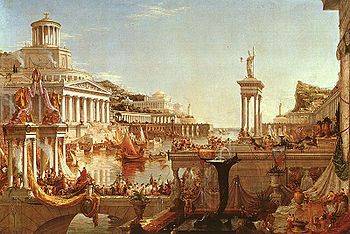 The third painting, The Consummation of Empire, shifts the viewpoint to the opposite shore, approximately the site of the clearing in the first painting. It is noontide of a glorious summer day. Both sides of the river valley are now covered in colonnaded marble structures, whose steps run down into the water. The megalithic temple seems to have been transformed into a huge domed structure dominating the river-bank. The mouth of the river is guarded by two pharoses, and ships with lateen sails go out to the sea beyond. A joyous crowd throngs the balconies and terraces as a scarlet-robed king or victorious general crosses a bridge connecting the two sides of the river in a triumphal procession. In the foreground an elaborate fountain gushes. The overall look suggests the height of ancient Rome.
The third painting, The Consummation of Empire, shifts the viewpoint to the opposite shore, approximately the site of the clearing in the first painting. It is noontide of a glorious summer day. Both sides of the river valley are now covered in colonnaded marble structures, whose steps run down into the water. The megalithic temple seems to have been transformed into a huge domed structure dominating the river-bank. The mouth of the river is guarded by two pharoses, and ships with lateen sails go out to the sea beyond. A joyous crowd throngs the balconies and terraces as a scarlet-robed king or victorious general crosses a bridge connecting the two sides of the river in a triumphal procession. In the foreground an elaborate fountain gushes. The overall look suggests the height of ancient Rome.
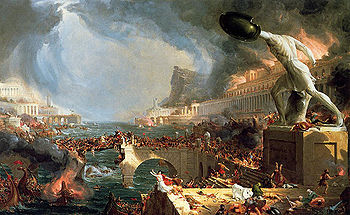 The fourth painting, Destruction, has almost the same perspective as the third, though the artist has stepped back a bit to allow a wider scene of the action, and moved almost to the center of the river. The action is the sack and destruction of the city, in the course of a tempest seen in the distance. It seems that a fleet of enemy warriors has overthrown the city's defenses, sailed up the river, and is busily firing the city and killing and raping its inhabitants. The bridge across which the triumphal procession had crossed is broken; a makeshift crossing strains under the weight of soldiers and refugees. Columns are broken, fire breaks from the upper floors of a palace on the river bank. In the foreground a statue of some venerable hero stands headless, still striding forward into the uncertain future, reminiscent of the hunter in the first painting. The scene is perhaps suggested by the Vandal sack of Rome
The fourth painting, Destruction, has almost the same perspective as the third, though the artist has stepped back a bit to allow a wider scene of the action, and moved almost to the center of the river. The action is the sack and destruction of the city, in the course of a tempest seen in the distance. It seems that a fleet of enemy warriors has overthrown the city's defenses, sailed up the river, and is busily firing the city and killing and raping its inhabitants. The bridge across which the triumphal procession had crossed is broken; a makeshift crossing strains under the weight of soldiers and refugees. Columns are broken, fire breaks from the upper floors of a palace on the river bank. In the foreground a statue of some venerable hero stands headless, still striding forward into the uncertain future, reminiscent of the hunter in the first painting. The scene is perhaps suggested by the Vandal sack of Rome
in 455
.
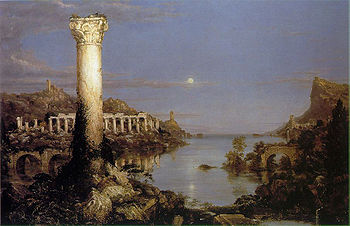 The fifth painting, Desolation, shows the results, years later. We view the remains of the city in the livid light of a dying day. The landscape has begun to return to wilderness, and no human beings are to be seen; but the remnants of their architecture emerge from beneath a mantle of trees, ivy, and other overgrowth. The broken stumps of the pharoses loom in the background. The arches of the shattered bridge, and the columns of the temple are still visible; a single column looms in the foreground, now a nesting place for birds. The sunrise of the first painting is mirrored here by a moonrise, a pale light reflecting in the ruin-choked river while the standing pillar reflects the last rays of sunset.
The fifth painting, Desolation, shows the results, years later. We view the remains of the city in the livid light of a dying day. The landscape has begun to return to wilderness, and no human beings are to be seen; but the remnants of their architecture emerge from beneath a mantle of trees, ivy, and other overgrowth. The broken stumps of the pharoses loom in the background. The arches of the shattered bridge, and the columns of the temple are still visible; a single column looms in the foreground, now a nesting place for birds. The sunrise of the first painting is mirrored here by a moonrise, a pale light reflecting in the ruin-choked river while the standing pillar reflects the last rays of sunset.
Thomas Cole
Thomas Cole was an English-born American artist. He is regarded as the founder of the Hudson River School, an American art movement that flourished in the mid-19th century...
in the years 1833-36. It is notable in part for reflecting popular American sentiments of the times, when many saw pastoralism
Pastoralism
Pastoralism or pastoral farming is the branch of agriculture concerned with the raising of livestock. It is animal husbandry: the care, tending and use of animals such as camels, goats, cattle, yaks, llamas, and sheep. It may have a mobile aspect, moving the herds in search of fresh pasture and...
as the ideal phase of human civilization, fearing that empire would lead to gluttony and inevitable decay.
The series was acquired by The New-York Historical Society
New-York Historical Society
The New-York Historical Society is an American history museum and library located in New York City at the corner of 77th Street and Central Park West in Manhattan. Founded in 1804 as New York's first museum, the New-York Historical Society presents exhibitions, public programs and research that...
in 1858 as a gift of the New-York Gallery of Fine Arts, and comprises the following works: The Course of Empire - The Savage State; The Course of Empire - The Arcadian or Pastoral State; The Course of Empire - The Consummation of Empire; The Course of Empire - Destruction; and The Course of Empire - Desolation.
The series of paintings depicts the growth and fall of an imaginary city, situated on the lower end of a river valley, near its meeting with a bay of the sea. The valley is distinctly identifiable in each of the paintings, in part because of an unusual landmark: a large boulder is precariously situated atop a crag overlooking the valley.
A direct source of literary inspiration for The Course of Empire paintings is Byron's Childe Harold's Pilgrimage
Childe Harold's Pilgrimage
Childe Harold's Pilgrimage is a lengthy narrative poem in four parts written by Lord Byron. It was published between 1812 and 1818 and is dedicated to "Ianthe". The poem describes the travels and reflections of a world-weary young man who, disillusioned with a life of pleasure and revelry, looks...
(1812–18). Cole quoted this verse, from Canto IV, in his newspaper advertisements for the series:
The paintings are currently on display at The New-York Historical Society
New-York Historical Society
The New-York Historical Society is an American history museum and library located in New York City at the corner of 77th Street and Central Park West in Manhattan. Founded in 1804 as New York's first museum, the New-York Historical Society presents exhibitions, public programs and research that...
. They were temporarily exhibited in Tate Britain
Tate Britain
Tate Britain is an art gallery situated on Millbank in London, and part of the Tate gallery network in Britain, with Tate Modern, Tate Liverpool and Tate St Ives. It is the oldest gallery in the network, opening in 1897. It houses a substantial collection of the works of J. M. W. Turner.-History:It...
in 2002.
The Savage State

The Arcadian or Pastoral State

Arcadia (utopia)
Arcadia refers to a vision of pastoralism and harmony with nature. The term is derived from the Greek province of the same name which dates to antiquity; the province's mountainous topography and sparse population of pastoralists later caused the word Arcadia to develop into a poetic byword for an...
or Pastoral State, the sky has cleared and we are in the fresh morning of a day in spring or early summer. The viewpoint has shifted further down the river, as the crag with the boulder is now on the left-hand side of the painting; a forked peak can be seen in the distance beyond it. Much of the wilderness has given way to settled lands, with plowed fields and lawns visible. Various activities go on in the background: plowing, boat-building, herding sheep, dancing; in the foreground, an old man sketches what may be a geometrical problem with a stick. On a bluff on the near side of the river, a megalithic temple has been built, and smoke (presumably from sacrifices) arises from it. The images reflect an idealized, pre-urban ancient Greece.
The Consummation of Empire

Destruction

Sack of Rome (455)
The sack of 455 was the second of three barbarian sacks of Rome; it was executed by the Vandals, who were then at war with the usurping Western Roman Emperor Petronius Maximus....
in 455
455
Year 455 was a common year starting on Saturday of the Julian calendar. At the time, it was known as the Year of the Consulship of Valentinianus and Anthemius...
.
Desolation


